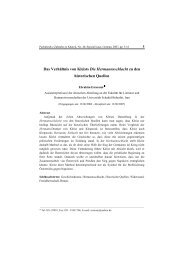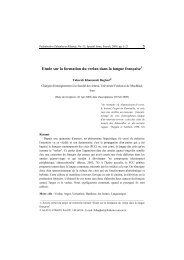Phonological Metathesis in Persian: Synchronic, Diachronic, and the ...
Phonological Metathesis in Persian: Synchronic, Diachronic, and the ...
Phonological Metathesis in Persian: Synchronic, Diachronic, and the ...
You also want an ePaper? Increase the reach of your titles
YUMPU automatically turns print PDFs into web optimized ePapers that Google loves.
28 Pazhuhesh-e Zabanha-ye Khareji, No. 56, Spr<strong>in</strong>g 2010<br />
enhance <strong>in</strong>dividuals’ sense of efficacy, especially when <strong>the</strong>re are a lot of similarities<br />
between <strong>the</strong> <strong>in</strong>dividual <strong>and</strong> <strong>the</strong> selected model. The third source of efficacy is called<br />
social persuasion which refers to <strong>the</strong> verbal encouragement people receive from<br />
o<strong>the</strong>rs. If <strong>the</strong> person who provides verbal persuasion is dependable, <strong>in</strong>dividuals’ selfefficacy<br />
tends to <strong>in</strong>crease. Physiological <strong>and</strong> emotional states constitute <strong>the</strong> last<br />
source of efficacy <strong>and</strong> perta<strong>in</strong> to people’s physical <strong>and</strong> affective condition dur<strong>in</strong>g<br />
task completion. For <strong>in</strong>stance, feel<strong>in</strong>gs of relaxation are signals of self-assurance<br />
<strong>and</strong>, <strong>the</strong>refore, enhance self-efficacy, while a rac<strong>in</strong>g heart beat or high blood<br />
pressure can lead to low efficacy beliefs.<br />
When it comes to <strong>the</strong> academic sett<strong>in</strong>g, teacher self-efficacy refers to teachers’<br />
judgment on <strong>the</strong>ir abilities to motivate students <strong>and</strong> improve <strong>the</strong>ir achievement<br />
(Campbell, 1996; Chacόn, 2005; Cruz & Arias, 2007; Hoy & Spero, 2005; Milner &<br />
Hoy, 2003; Ross & Bruce, 2007; Ross et al., 1996; Weately, 2005). There are so<br />
many factors which may <strong>in</strong>fluence this psychological construct, but <strong>the</strong>y can be<br />
classified under two broad categories; contextual <strong>and</strong> demographic factors.<br />
As for <strong>the</strong> first category, it is said that teacher self-efficacy is a k<strong>in</strong>d of contextspecific<br />
construct (Chacόn, 2005; Dell<strong>in</strong>ger et al., 2008) <strong>and</strong> is shaped with<strong>in</strong> a<br />
particular environment (Friedman & Kass, 2002; Tschannen-Moran, Hoy, & Hoy,<br />
1998). It is supposed to be affected by such factors as <strong>the</strong> pr<strong>in</strong>cipal leadership <strong>and</strong><br />
school climate (Tschannen-Moran & Hoy, 2007). More precisely, if teachers have<br />
access to more resources <strong>in</strong> <strong>the</strong> school <strong>and</strong> enjoy <strong>the</strong> pr<strong>in</strong>cipal’s support, <strong>the</strong>y are<br />
more likely to have stronger self-efficacy beliefs (Deemer, 2004; Hoy, & Woolfolk,<br />
1993; Tschanne-Moran & Hoy, 2002). In addition, teachers who receive guidance<br />
from <strong>the</strong>ir colleagues feel more efficacious, regardless of whe<strong>the</strong>r it is <strong>in</strong> <strong>the</strong> form of<br />
supervision (Chester & Beud<strong>in</strong>, 1996; Coladarci & Breton, 1997), mentor<strong>in</strong>g, or<br />
<strong>in</strong>terdiscipl<strong>in</strong>ary teams (Warren & Pyne, 1997). Also, <strong>the</strong> class size can affect<br />
teachers’ sense of efficacy <strong>in</strong> that <strong>the</strong>y possess stronger efficacy beliefs if <strong>the</strong>y teach<br />
larger classes (Lee et al., 1991; Raudenbush et al., 1992). Students’ characteristics<br />
might affect teacher efficacy as ano<strong>the</strong>r contextual factor. For <strong>in</strong>stance, Bejarano<br />
(2000) found that students’ gender has no effect on teachers’ perceived efficacy (i.e.,






